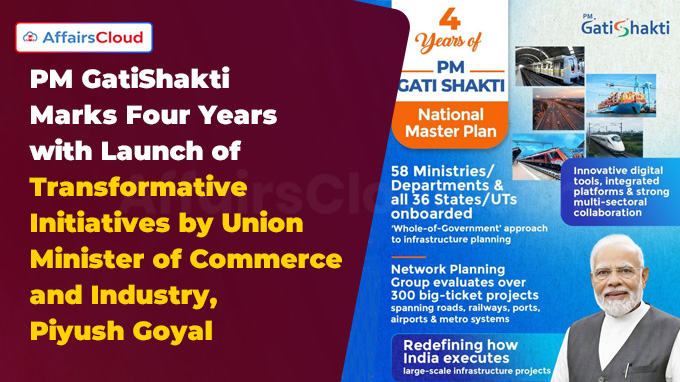On October 13, 2025, Union Minister Piyush Goyal, Ministry of Commerce and Industry (MoC&I), launched and unveiled a series of transformative initiatives and projects by the Logistics Division, Department for Promotion of Industry and Internal Trade (DPIIT), MoC&I, marking the 4th anniversary of Pradhan Mantri GatiShakti – National Master Plan (PMGS-NMP) at Bharat Mandapam in New Delhi, Delhi.
- The initiatives aim to drive socio-economic development by strengthening infrastructure planning, enhancing last-mile connectivity, and ensuring better infrastructure for overall growth.
Exam Hints:
- What? 4th Anniversary of PM GatiShakti NMP
- When? On October 13, 2025
- Marked by: Unveiled several initiatives by Union Minister Piyush Goyal, MoC&I,
- Organizer: Logistics Division (DPIIT)
- Launches: PMGS Offshore, PMGS Public, KMS, DUMS, PMGS NMP Dashboard, PMGS Compendium Volume-3, LEAPS 2025
- PMGS NMP Launch: On October 13, 2021
- Implementation: MoC&I via DPIIT Logistics Division
- 4-Year Achievements (till Oct 13, 2025):
- Over 300 major projects evaluated
- All 36 states & UTs developed SMP portals; 600+ projects mapped
- PMGS-DMP portal expanded to 112 aspirational districts
About Pradhan Mantri GatiShakti – National Master Plan (PMGS-NMP):
Overview: PMGS – NMP, a “Whole-of-Government” approach, by the Government of India (GoI), was launched on 13th October 2021 by Prime Minister (PM) Narendra Modi with the budget outlay of Rs.100 crores for reshaping India’s infrastructure over the next five years.
Implementation: The PMGS-NMP is executed by the MoC&I through the Logistics Division of the DPIIT.
Aim: It aims to bring various infrastructure development projects in sectors such as roads, railways, ports, airports, and logistics, under a single platform, ensuring integrated, coordinated, and data-driven planning across ministries and states.
Seven Engines: The initiative integrates seven major engines of economic growth such as Roads and Highways, Railways, Ports, Waterways, Airports and Aviation, Mass Transport, and Logistics Infrastructure.
Developer: The plan has been developed as a Digital Master Planning tool by Bhaskaracharya National Institute for Space Applications and Geo-informatics, (BISAG-N), Gandhinagar (Gujarat).
Six Pillars: The plan is built on six key pillars such as Comprehensiveness, Prioritization, Optimization, Synchronization,Analytical and Dynamic.
GatiShakti Digital Platform:
Overview: It is built on a dynamic Geographic Information System (GIS) platform that brings together data from all Ministries and Departments into one comprehensive database. The system provides real-time mapping and updates of infrastructure projects.
Data Source: The map, developed with open-source technologies, securely hosted on MEGHRAJ, a cloud platform of GoI, uses satellite imagery from Indian Space Research Organization (ISRO) and incorporates base maps from the Survey of India (SOI).
- It integrates over 1,700 data layers from 57 ministries & departments and 36 States and Union Territories (UTs), enabling faster approvals, optimized routes, and early identification of potential conflicts.
Mapping: It includes maps of existing and proposed infrastructure, economic zones, industrial corridors, social amenities, and environmental features.
Implementation Framework: A three-tier institutional framework, including The Empowered Group of Secretaries (EGoS), The Network Planning Group (NPG), and The Technical Support Unit (TSU) have been established to implement and monitor the plan effectively.
- EGoS, chaired by the Cabinet Secretary of India (CSI) (Presently T.V. Somanathan), provides high-level direction, coordination, and resolution of inter-ministerial issues.
- NPG, comprising senior officials from seven key infrastructure ministries such as Railways, Roads, Ports, Civil Aviation, Power, Petroleum, and Telecom. It evaluates all infrastructure proposals before approval to ensure multimodal connectivity and synergy.
- TSU, managed by the Logistics Division of DPIIT, provides technical and analytical support, geospatial integration, and capacity-building.
Structure of NMP:
The NMP acts as the central layer, integrating multiple State Master Plans (SMPs) and District Master Plans (DMPs).
NMP: It covers national-level projects, including highways, ports, industrial corridors, and dedicated freight corridors.
SMP: It focuses on state-specific infrastructure and logistic projects, aligned with NMP.
DMP: It handles ground-level planning, emphasizing local connectivity, last-mile linkages, and area development.
Four-Year Achievements:
Project Evaluation: As on October 13, 2025, NPG has evaluated over 300 major infrastructure projects using PMGS-NMP principles, including integrated planning, last-mile connectivity, intermodal linkages, enhanced logistics efficiency, and synchronized project implementation.
State-level Implementation: All 36 States and Union Territories (UTs) have developed SMP portals, with over 600 projects planned and mapped on the PM GatiShakti–NMP portal.
Ministries Expansion: The initiative now covers social and economic ministries, using PMGS-NMP to identify infrastructure gaps and improve planning in sectors like healthcare, education, postal services, and tribal development.
District-level Planning: The PMGS-DMP portal, developed with BISAG-N, facilitates district level planning for 28 Aspirational Districts. It promotes cross-sector collaboration and uses technologies such as Artificial Intelligence (AI) and Internet of Things (IoT) for integrated socio-economic planning.
Training: DPIIT has provided extensive training through Integrated Government Online Training (iGOT) courses, workshops, and interactive sessions, reaching over 20,000 officials.
Capacity Building: DPIIT signed Memorandum of Understandings (MoUs) with GatiShakti Vishwavidyalaya and the Korea Transport Institute (KOTI), focusing on skill development, knowledge sharing, and technical assistance in infrastructure and logistics planning.
International Collaborations: It is underway with countries, including Nepal, Bangladesh, Sri Lanka, Madagascar, Senegal, and Gambia, to promote the adoption of PMGS and geospatial technology in integrated infrastructure planning.
Experiential Centre: On October 13, 2024, the PM GatiShakti Anubhuti Kendra (Experiential Centre) was inaugurated by PM Narendra Modi at India Trade Promotion Organization (ITPO) in New Delhi. It features holographic displays, Augmented Reality (AR) and Virtual Reality (VR) experiences, and interactive simulations.
About Key Initiatives Launched:
PM GatiShakti-Offshore: Union Minister Piyush Goyal unveiled “PM GatiShakti-Offshore”, a digital platform, launched by the Logistics Division of DPIIT.
- It promotes sustainable offshore development by enabling multi-layered analysis and visualization, strengthening India’s Blue Economy.
- The platform’s Unified Geospatial Interface (UGI) integrates data on energy, environment, infrastructure, and oceanic hazards to help plan projects efficiently while reducing ecological risks and delays.
District Expansion: On the success of PMGS-DMP in 28 Aspirational districts, it was rolled out across all 112 Aspirational districts, promoting data-driven, integrated planning across India.
KMS: Launched Knowledge Management System (KMS) to serve as a centralized digital repository for all resources related to PMGS. It encompasses digital tools, Standard Operating Procedures (SOPs), use cases, compendiums, and training materials.
DUMS: Launched Decentralized Data Uploading and Management System (DUMS) to ensure accurate, standardized, and accountable management of data related to infrastructure projects.
- It operates in a three-stage process such as Data upload by designated managers, Review by nodal officers, and Final publication by BISAG-N.
PMGS NMP Dashboard: It was launched to provide a real-time overview of ongoing infrastructure projects under PMGS, enabling data-driven governance to improve project monitoring and timely interventions.
- It displays information on onboarded data layers, registered users, planned projects, and reported issues, and forms the basis of the Comprehensive Multi-Sector Reporting System (CMSRS), enabling decision-makers to track project progress, identify bottlenecks, and prioritize interventions.
PMGS Compendium Volume-3: Launched to showcases PMGS’s impact by documenting success stories in infrastructure, social, and economic sectors, highlighting integrated planning, project execution, and geospatial innovations.
PM GatiShakti Public: It is a Query-Based web platform, launched through the UGI. It provides private entities, consultants, researchers, and citizens, regulated access to non-sensitive infrastructure and geospatial data from the NMP.
- It is developed by BISAG-N, powered by the National Geospatial Data Registry (NGDR) and provides access to 230 approved datasets.
LEAPS 2025: Logistics Excellence, Advancement, and Performance Shield (LEAPS) 2025 is a flagship initiative by DPIIT to recognize and celebrate excellence, innovation and leadership in India’s logistics sector.
- It includes all logistics players, including air, road, sea, and rail freight operators, warehousing, multimodal transporters, Micro Small and Medium Enterprises (MSMEs), startups, and academia.
Promotion: The initiative promotes sustainability, Environmental, Social, and Governance (ESG) practices, and green logistics.
Categories: The registrations are open until November 15, 2025, on the Rashtriya Puraskar Portal which can be accessed via https://awards.gov.in/. The entries are invited across 13 categories, including:
- Core Logistics: Air, Road, Maritime, Rail, Multimodal Transport Operators, Warehousing (Industrial, Consumables & Agriculture)
- MSMEs: Logistics Service Providers
- Startups: Logistics Technology & Operations Service Providers
- Institutions: Education Institutions promoting logistics
- Special Category: Logistics Service Delivery for electronic (e)-commerce operations, Multimodal Logistics Service Provider (MLSP) such as Third Party (3P) LSP, Freight Forwarder, Custom Broker & Agent.
About Ministry of Commerce and Industry (MoC&I):
Union Minister – Piyush Goyal (Constituency – Mumbai North, Maharashtra)
Minister of State (MoS) – Jitin Prasada (Constituency – Pilibhit, Uttar Pradesh, UP)





